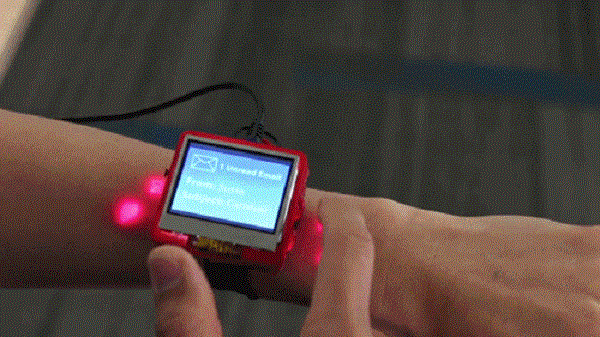For some people, letting go of hardware buttons in smartphones and wearables is pretty difficult. The one’s who don’t think touchscreens are that appealing should give laser skin buttons a try.
The problem with wearables is that they really don’t have enough room for physical buttons. Apple claims to have found a solution to displaying images and other things on tiny displays, in the form of the digital crown that enables zooming in and out. Still, maybe people are looking for more functionality in a smartwatch, not just to zoom and scroll. For example, since these wearables are designed to display notifications, among many other things, maybe it would be useful if one button was used for cutting some text, and another one for pasting it somewhere else. Getting one button for each function is not exactly desirable in this day and age, and creating shortcuts by pushing multiple buttons at once would actually defeat the purpose of a variable. What if there was a way to project buttons on the skin, and this way assign their functions depending on the app that’s currently running? That’s pretty much what Carnegie Mellon’s Future Interfaces Group did with the ‘skin buttons‘.

The skin buttons, which are quite thoroughly documented in the accompanying research paper, are currently but a proof of concept. Four micro lasers are used for projecting icon shapes on the skin. It’s possible to display any button with any functionality, supposing that everything is linked to the smartwatch’s software.
If there had been only the four lasers, it wouldn’t have been possible for you to trigger any actions when touching a skin button. However, there also are infrared sensors that can detect when you’re tapping on the skin. The concept used here is very similar to the one that made projected keyboards functional.
There’s plenty of room for improvement, and the researchers who developed skin buttons are well aware of that. The buttons could be assigned various colors, in order to help users differentiate them. On top of that, there’s work to do on the software side of things. I think that skin buttons could become particularly useful for games on smartwatches and other wearables. Now I wonder if any of the tech giants will pick up this idea and implement it in the Android Wear smartwatches.
Be social! Follow Walyou on Facebook and Twitter, and read more related stories about the Wristify personal cooling and heating bracelet, and the TomTom Golfer smartwatch.










